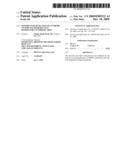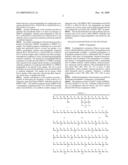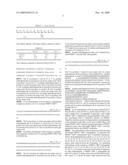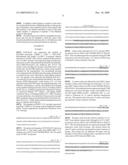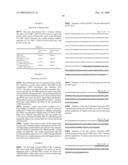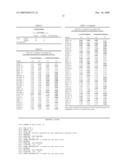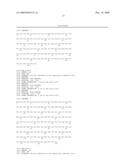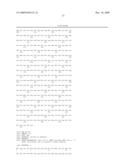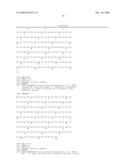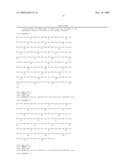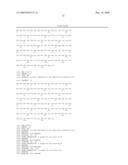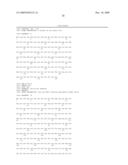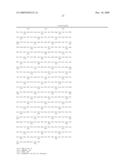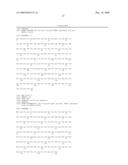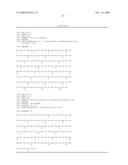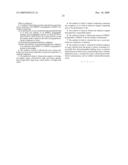Patent application title: Peptides for Detection of Antibody to Porcine Reproductive Respiratory Syndrome Virus
Inventors:
Eugene Regis Krah, Iii (Freeport, ME, US)
Eugene Regis Krah, Iii (Freeport, ME, US)
IPC8 Class: AC12Q170FI
USPC Class:
435 5
Class name: Chemistry: molecular biology and microbiology measuring or testing process involving enzymes or micro-organisms; composition or test strip therefore; processes of forming such composition or test strip involving virus or bacteriophage
Publication date: 2009-12-10
Patent application number: 20090305232
Claims:
1. A method of detecting a porcine reproductive and respiratory syndrome
virus (PRRSV) polypeptide or PRRSV in a sample comprising:(a) contacting
one or more antibodies that specifically bind to at least one epitope of
an PRRSV polypeptide, wherein said polypeptide consists of SEQ ID NO:1,
SEQ ID NO:2, SEQ ID NO:18, or SEQ ID NO:13 with the sample under
conditions that allow polypeptide/antibody complexes to form;(b)
detecting polypeptide/antibody complexes;wherein the detection of
polypeptide/antibody complexes is an indication that PRSSV or a PRSSV
polypeptide is present in the sample.
2. The method of claim 1, wherein the one or more antibodies are monoclonal antibodies, polyclonal antibodies, or antibody fragments.
3. The method of claim 1, wherein the sample is a biological sample, serum, whole blood, milk, meat juice, sputum, lung lavage fluid, lung tissue, tonsil tissue, or lymph node tissue.
4. The method of claim 1, further comprising contacting the complexes of (a) with an indicator reagent comprising prior to the performance of (b).
5. The method of claim 4, wherein the indicator reagent that generates a measurable signal.
6. The method of claim 1, wherein the amount of PRRSV polypeptide or PRRSV in the test sample is determined.
7. The method of claim 1, wherein the one or more antibodies are attached to a substrate.
8. The method of claim 1, wherein the method comprises an assay selected from the group of assays consisting of a reversible flow chromatographic binding assay, an enzyme linked immunosorbent assay, a radioimmunoassay, a hemagglutination assay, a western blot assay, a fluorescence polarization immunoassay, and an indirect immunofluorescence assay.
Description:
PRIORITY
[0001]This application is a divisional application of U.S. Ser. No. 11/362,599, filed Feb. 24, 2006 (now allowed), which claims the benefit of U.S. Appl. No. 60/656,348, filed Feb. 25, 2005, both of which are incorporated herein by reference in their entirety.
FIELD OF THE INVENTION
[0002]The invention relates to methods and compositions for the detection and quantification of porcine reproductive respiratory syndrome virus (PRRSV) antibodies and antibody fragments using PRRSV polypeptides.
BACKGROUND OF THE INVENTION
[0003]Porcine reproductive and respiratory syndrome virus (PRRSV) is an Arterivirus (RNA enveloped virus) that causes porcine reproductive and respiratory syndrome (PRRS). The virus can cause major reproductive problems in adult pigs resulting in abortion. In growing pigs the symptoms include increased mortality, decreased appetite, fever, respiratory problems, pneumonia, increased secondary bacterial infections, and atrophic rhinitis. In neonatal pigs the virus can cause respiratory distress, a failure to thrive, and increased secondary bacterial infections. The virus is spread primarily by pig to pig. The virus can also be spread through infected feces, urine and milk to piglets without colostral antibodies. Additionally, transmission through needles, insects, and air is possible.
[0004]Methods of detection of PRRSV are needed in the art. PRRS antibody detection kits are commercially available such as, for example, the HerdChek® PRRS Antibody 2XR Test Kit (IDEXX Labs, Inc., Westbrook, Me.).
SUMMARY OF THE INVENTION
[0005]One embodiment of the invention provides a composition of matter comprising a purified polypeptide consisting essentially of SEQ ID NO:1 or SEQ ID NO:12. The purified polypeptide can further comprise one or more amino acids at either terminus that are not contiguously associated with a PRRSV ORF7 in nature. The purified polypeptide can be in a multimeric form. The composition can further comprise a carrier. The purified polypeptide can be linked to an indicator reagent, an amino acid spacer, an amino acid linker, a signal sequence, a stop transfer sequence, a transmembrane domain, a protein purification ligand, or a combination thereof. The purified polypeptide can consist essentially of SEQ ID NO:2 or SEQ ID NO:13 and one or more polypeptides not contiguously associated with SEQ ID NO:1, SEQ ID NO:2, SEQ ID NO:18, or SEQ ID NO:13 in nature. The one or more polypeptides not contiguously associated with SEQ ID NO:1, SEQ ID NO:2, SEQ ID NO:18, or SEQ ID NO:13 in nature can be non-PRRSV polypeptides.
[0006]Another embodiment of the invention provides a purified fusion polypeptide comprising a polypeptide consisting essentially of SEQ ID NO:1 or SEQ ID NO:18 and one or more polypeptides not contiguously associated with SEQ ID NO:1 or SEQ ID NO:18 in nature. The one or more polypeptides not contiguously associated with SEQ ID NO:1 or SEQ ID NO:18 in nature can be a non-PRRSV polypeptide. SEQ ID NO:1 or SEQ ID NO:18 can be in multimeric form. The purified fusion polypeptide can comprise an indicator reagent, an amino acid spacer, an amino acid linker, a signal sequence, a stop transfer sequence, a transmembrane domain, a protein purification ligand or a combination thereof. The purified polypeptide can consist essentially of SEQ ID NO:2 or SEQ ID NO:13.
[0007]Yet another embodiment of the invention provides a purified polynucleotide encoding the purified polypeptides and purified fusion polypeptides of the invention.
[0008]Still another embodiment of the invention provides a method of detecting antibodies that specifically bind reproductive respiratory syndrome virus (PRRSV) or a PRRSV polypeptide. The method comprises contacting a purified polypeptide consisting essentially of SEQ ID NO:1, SEQ ID NO:2, SEQ ID NO:18, or SEQ ID NO:13 or a combination thereof, with a test sample suspected of comprising antibodies specific for PRRSV, under conditions that allow polypeptide/antibody complexes to form and detecting polypeptide/antibody complexes. The detection of polypeptide/antibody complexes is an indication that antibodies specific for PRRSV are present in the test sample, and the absence of polypeptide/antibody complexes is an indication that antibodies specific for PRSSV are not present in the test sample. The method can further comprise contacting the polypeptide/antibody complexes with an indicator reagent comprising prior to their detection. The antibodies can be fragments of antibodies. The amount of antibody in the test sample can be determined. The polypeptide can be attached to a substrate. The polypeptide can be in a multimeric form. The polypeptide can be a fusion protein comprising SEQ ID NO:1, SEQ ID NO:2, SEQ ID NO:18, or SEQ ID NO:13 or a combination thereof and one or more polypeptides not contiguously associated with SEQ ID NO:1, SEQ ID NO:2, SEQ ID NO:18, or SEQ ID NO:13 in nature. The one or more polypeptides not contiguously associated with SEQ ID NO:1, SEQ ID NO:2, SEQ ID NO:18, or SEQ ID NO:13 in nature can be non-PRRSV polypeptides. The test sample can comprise a biological sample obtained from a mammal. The method can comprise an assay selected from the group of assays consisting of a reversible flow chromatographic binding assay, an enzyme linked immunosorbent assay, a radioimmunoassay, a hemagglutination assay, a western blot assay, a fluorescence polarization immunoassay, and an indirect immunofluorescence assay.
[0009]Even another embodiment of the invention provides a method of detecting a PRRSV infection in a mammal. The method comprises obtaining a biological sample from a mammal suspected of having a PRRSV infection; contacting a purified polypeptide consisting essentially of SEQ ID NO:1, SEQ ID NO:2, SEQ ID NO:18, or SEQ ID NO:13 or a combination thereof, with the biological sample under conditions that allow polypeptide/antibody complexes to form; and detecting polypeptide/antibody complexes. The detection of polypeptide/antibody complexes is an indication that the mammal has a PRSSV infection and the absence of polypeptide/antibody complexes is an indication that the mammal does not have a PRRSV infection. The method can further comprise contacting the polypeptide/antibody complexes with an indicator reagent that generates a measurable signal prior to the detection. The polypeptide can be a fusion protein consisting essentially of SEQ ID NO:1, SEQ ID NO:2, SEQ ID NO:18, or SEQ ID NO:13 or a combination thereof and one or more polypeptides not contiguously associated with SEQ ID NO:1, SEQ ID NO:2, SEQ ID NO:18, or SEQ ID NO:13 in nature.
[0010]Another embodiment of the invention provides an antibody that specifically binds to at least one epitope of a PRRSV polypeptide, wherein said polypeptide is SEQ ID NO:1, SEQ ID NO:2, SEQ ID NO:18, or SEQ ID NO:13. The antibody can be a monoclonal antibody, polyclonal antibody or antibody fragment.
[0011]Yet another embodiment of the invention provides a method of detecting a PRRSV polypeptide or PRRSV in a sample. The method comprises contacting one or more antibodies that specifically bind to at least one epitope of an PRRSV polypeptide, wherein said polypeptide comprises SEQ ID NO:1, SEQ ID NO:2, or SEQ ID NO:18, or SEQ ID NO:13 with the sample under conditions that allow polypeptide/antibody complexes to form; and detecting polypeptide/antibody complexes. The detection of polypeptide/antibody complexes is an indication that PRSSV or a PRSSV polypeptide is present in the sample and the absence of polypeptide/antibody complexes is an indication that PRSSV or a PRRSV polypeptide is not present in the sample. The one or more antibodies are monoclonal antibodies, polyclonal antibodies, or antibody fragments. The sample can be serum, whole blood, sputum, milk, meat juice, lung lavage fluid, lung tissue, tonsil tissue, or lymph node tissue.
[0012]Another embodiment of the invention provides a method of decreasing the incidence of false positives in a diagnostic assay that detects PRRSV antibodies specific for PRRSV ORF 7. The method comprises using a PRRSV ORF 7 polypeptide comprising about 19 to about 28 N-terminal amino acid deletions as an antibody capture antigen in the diagnostic assay. The PRRSV ORF7 polypeptide can be SEQ ID NO:1 or SEQ ID NO:18. The polypeptide can further comprise one or more amino acids at either terminus that are not contiguously associated with a PRRSV ORF7 in nature.
[0013]The invention therefore provides methods and compositions that can be used to detect PRRSV antibodies and antibody fragments using polypeptides with sensitivity and specificity.
DETAILED DESCRIPTION OF THE INVENTION
PRRSV Polypeptides
[0014]A polypeptide is a polymer of three or more amino acids covalently linked by amide bonds. A polypeptide can be post-translationally modified. A purified polypeptide is a polypeptide preparation that is substantially free of cellular material, other types of polypeptides, chemical precursors, chemicals used in synthesis of the polypeptide, or combinations thereof. A polypeptide preparation that is substantially free of cellular material, culture medium, chemical precursors, chemicals used in synthesis of the polypeptide has less than about 30%, 20%, 10%, 5%, 1% or more of other polypeptides, culture medium, chemical precursors, and/or other chemicals used in synthesis. Therefore, a purified polypeptide is about 70%, 80%, 90%, 95%, 99% or more pure.
[0015]Purified polypeptides of the invention can either be full-length polypeptides or fragments of polypeptides.
[0016]The sequences of three US ORF 7 strains of PRRSV:VR-2332 (Bold) (U.S. Pat. No. 5,998,601) (SEQ ID NO:8); ISU-12 (Underlined) (SEQ ID NO:9); and US-A (Italics) (SEQ ID NO:10) are compared in Table 1.
TABLE-US-00001 TABLE 1 M P N N N G K Q T E E K K G D G Met Pro Asn Asn Asn Gly Lys Gln Thr Gln Gln Lys Lys Gly Asp Gly T Q K R Thr Gln Lys Arg Q K K Gln Lys Lys 1 5 10 15 Q P V N Q L C Q M L G K I I A Q Gln Pro Val Asn Gln Leu Cys Gln Met Leu Gly Lys Ile Ile Ala Gln H His 20 25 30 Q N Q S R G K G P G K K N K K K Gln Asn Gln Ser Arg Gly Lys Gly Pro Gly Lys Lys Asn Lys Lys Lys 35 40 45 N P E K P H F P L A T E D D V R Asn Pro Glu Lys Pro His Phe Pro Leu Ala Thr Glu Asp Asp Val Arg 50 55 60 H H F T P S E R Q L C L S S I Q His His Phe Thr Pro Ser Glu Arg Gln Leu Cys Leu Ser Ser Ile Gln 65 70 75 80 T A F N Q G A G T C T L S D S G Thr Ala Phe Asn Gln Gly Ala Gly Thr Cys Thr Leu Ser Asp Ser Gly 85 90 95 R I S V T V E F S L P T H H T V Arg Ile Ser Tyr Thr Val Glu Phe Ser Leu Pro Thr His His Thr Val 100 105 110 R L I R V T A S P S A Arg Leu Ile Arg Val Thr Ala Ser Pro Ser Ala P Pro 115 120
The relative identity of the three strains is shown in Table 2.
TABLE-US-00002 TABLE 2 VR-2332 ISU-12 US-A VR-2332 100 95.9 96.7 ISU-12 95.9 100 96.7 US-A 96.7 96.7 100
The consensus sequence is shown in SEQ ID NO:11:
TABLE-US-00003 MPNNXGKQXX EKKGDGQPVN QLCQMLGKII AXQNQSRGKG 40 PGKKNKKKNP EKPHFPLATE DDVRHHFTPS ERQLCLSSIQ 80 TAFNQGAGTC TLSDSGRISY TVEFSLPTHH TVRLIRVTAX PSA 123
[0017]The X at position 5 can be N or T. In another embodiment the X at position 5 can be any amino acid. The X at position 9 can be Q or T. In another embodiment the X at position 9 can be any amino acid. The X at position 10 can be E or K. In another embodiment the X at position 10 can be any amino acid. The X at position 11 can be E, R or K. In another embodiment the X at position 11 can be any amino acid. The X at position 32 can be Q or H. In another embodiment the X at position 32 can be any amino acid. The X at position 120 can be S or P. In another embodiment the X at position 120 can be any amino acid.
[0018]In one embodiment of the invention a polypeptide comprises a portion of a U.S. serotype PRRSV ORF7:
TABLE-US-00004 (SEQ ID NO: 1) LCQXLGKIIAXQNQSRGKGPGKKNKKKNPEKPHFPLATEDDVRHHFTPSE RQLCLSSIQTAFNQGAGTCTLSDSGRISYTVEFSLPTHHTVRLIRVTAXP SA.
[0019]The X at position 11 can be any amino acid. In other embodiments the X at position 11 can be Q or H. The X at position 99 can be any amino acid. In other embodiments, the X at position 99 can be P or S. The X at position 4 can be any amino acid.
[0020]In another embodiment of the invention, a polypeptide comprises a portion of a U.S. serotype PRRSV ORF7 and a histidine tag:
TABLE-US-00005 (SEQ ID NO: 2) MRGSHHHHHHGMASMTGGQQMGRDLYDDDDKDHPFTGSLCQXLGKIIAXQ NQSRGKGPGKKNKKKNPEKPHFPLATEDDVRHHFTPSERQLCLSSIQTAF NQGAGTCTLSDSGRISYTVEFSLPTHHTVRLIRVTAXPSA.
[0021]The X at position 42 stands for any amino acid. In certain embodiments the X at position 42 can be M or I. The X at position 49 stands for any amino acid. In certain embodiments the X at position 49 stands for Q or H. The X at position 137 stands for any amino acid. In certain embodiments the X at position 137 stands for P or S.
[0022]Another embodiment provides an N terminal truncated PRRSV Lelystad ORF7 polypeptide.
TABLE-US-00006 (SEQ ID NO: 12) CQLLGAXIKSQRQQPRGGQAKKKKPEKPHFPLAAEDDIRHHLTQTERSLC LQSIQTAFNQGAGTASLSSSGEVSFQVEFMLPVAHTVRLIRVTSTSASQG AS.
The X at position 7 stands for any amino acid. In certain embodiments, the X at position 7 can be either M or I. Another embodiment is CQLLGAXIKSQRQQPRGGQAKKKKPEKPHFP LAAEDDIRHHLTQTERSLCLQSIQTAFNQGAGTASLSSSGEVSFQVEFMLPVAHTVRLIR VTSTSASQGAS (SEQ ID NO:18). The X at position 7 can be any amino acid. In preferred embodiments the X at position 7 is M or I.
[0023]Another embodiment provides a His-tagged N-truncated PRRSV Lelystad ORF7 polypeptide: MRGSHHHHHHGMASMTGGQQMGRDLYDDDDKDHPFTGSCQLLGAXIKSQRQQPRGG QAKKKKPEKPHFPLAAEDDIRHHLTQTERSLCLQSIQTAFNQGAGTASLSSSGEVSFQVE FMLPVAHTVRLIRVTSTSASQGAS (SEQ ID NO:13). The X at position 45 stands for any amino acid. In certain embodiments, the X at position 45 can be either M or I.
[0024]In one embodiment of the invention SEQ ID NO:1 SEQ ID NO:2, SEQ ID NO:12, and/or SEQ ID NO:13 are more soluble than a polypeptide comprising a full length PRRSV ORF7. Additionally, the polypeptides of the invention specifically bind to antibodies specific for PRRSV. Therefore, the basic and novel characteristics of polypeptides of the invention is that they can be more soluble than a full length PRRSV ORF7, they have greater specificity in PRRSV detection assays than full length PRRSV ORF7, and they specifically bind to anti-PRRSV antibodies.
[0025]One embodiment of the invention provides less than full length PRRSV ORF7 polypeptides. In particular the PRRSV ORF7 polypeptides have N-terminal truncations. That is, the polypeptides have about 1, 2, 3, 4, 5, 6, 7, 8, 9, 10, 11, 12, 13, 14, 15, 16, 17, 18, 19, 20, 21, 22, 23, 24, 25, 26, 27, 28, 29, 30, 31, 32, 33, 34, 35, 36, 37, 38, 39, 40, 41, 42, or 43 amino acids removed from the N-terminus. In a preferred embodiment of the invention a PRRSV ORF7 polypeptide has about 15, 16, 17, 18, 19, 20, 21, 22, 23, 24, 25, 26, 27, 28, 29, 30, 31, or 32 amino acids removed from the N-terminus. In other embodiments, a PRRSV ORF 7 polypeptide has about 16 to about 31 amino acids removed from the N-terminus; about 17 to about 30 amino acids removed from the N-terminus; about 18 to about 29 amino acids removed from the N-terminus; about 19 to about 28 amino acids removed from the N-terminus; about 20 to about 27 amino acids removed from the N-terminus; or about 21 to about 26 amino acids removed from the N-terminus. If present, the M residue that occurs in US PRRSV ORF 7 at about position 25 and the at about position 33 of Lelystad PRRSV can be replaced with another amino acid. See, e.g., SEQ ID NO:1 and SEQ ID NO:18.
[0026]Fragments of polypeptides of the invention can comprise about 5, 10, 15, 20, 30, 40, 50, 60, 70, 80, or more amino acids of polypeptides of the invention. Variant polypeptides are at least about 80, or about 90, 96, 98, or 99% identical to the polypeptide sequences shown in SEQ ID NO:1, SEQ ID NO:2, SEQ ID NO:12, or SEQ ID NO:13 and are also polypeptides of the invention. Variant polypeptides have one or more conservative amino acid variations or other minor modifications and retain biological activity, i.e., are biologically functional equivalents. A biologically active equivalent has substantially equivalent function when compared to the corresponding wild-type polypeptide.
[0027]Percent sequence identity has an art recognized meaning and there are a number of methods to measure identity between two polypeptide or polynucleotide sequences. See, e.g., Lesk, Ed., Computational Molecular Biology, Oxford University Press, New York, (1988); Smith, Ed., Biocomputing: Informatics And Genome Projects, Academic Press, New York, (1993); Griffin & Griffin, Eds., Computer Analysis Of Sequence Data, Part I, Humana Press, New Jersey, (1994); von Heinje, Sequence Analysis In Molecular Biology, Academic Press, (1987); and Gribskov & Devereux, Eds., Sequence Analysis Primer, M Stockton Press, New York, (1991). Methods for aligning polynucleotides or polypeptides are codified in computer programs, including the GCG program package (Devereux et al., Nuc. Acids Res. 12:387 (1984)), BLASTP, BLASTN, FASTA (Atschul et al., J. Molec. Biol. 215:403 (1990)), and Bestfit program (Wisconsin Sequence Analysis Package, Version 8 for Unix, Genetics Computer Group, University Research Park, 575 Science Drive, Madison, Wis. 53711) which uses the local homology algorithm of Smith and Waterman (Adv. App. Math., 2:482-489 (1981)). For example, the computer program ALIGN which employs the FASTA algorithm can be used, with an affine gap search with a gap open penalty of -12 and a gap extension penalty of -2.
[0028]When using any of the sequence alignment programs to determine whether a particular sequence is, for instance, about 95% identical to a reference sequence, the parameters are set such that the percentage of identity is calculated over the full length of the reference polynucleotide and that gaps in identity of up to 5% of the total number of nucleotides in the reference polynucleotide are allowed.
[0029]Variants can generally be identified by modifying one of the polypeptide sequences of the invention, and evaluating the properties of the modified polypeptide to determine if it is a biological equivalent. A variant is a biological equivalent if it reacts substantially the same as a polypeptide of the invention in an assay such as an immunohistochemical assay, an enzyme-linked immunosorbent Assay (ELISA), a radioimmunoassay (RIA), immunoenzyme assay or a western blot assay, e.g., has 90-110% of the activity of the original polypeptide. In one embodiment, the assay is a competition assay wherein the biologically equivalent polypeptide is capable of reducing binding of the polypeptide of the invention to a corresponding reactive antigen or antibody by about 80, 95, 99, or 100%. An antibody that specifically binds a corresponding wild-type polypeptide also specifically binds the variant polypeptide. Variant polypeptides of the invention can comprise about 1, 2, 3, 4, 5, or 6 conservative amino acid substitutions.
[0030]A conservative substitution is one in which an amino acid is substituted for another amino acid that has similar properties, such that one skilled in the art of peptide chemistry would expect the secondary structure and hydropathic nature of the polypeptide to be substantially unchanged. In general, the following groups of amino acids represent conservative changes: (1) ala, pro, gly, glu, asp, gln, asn, ser, thr; (2) cys, ser, tyr, thr; (3) val, ile, leu, met, ala, phe; (4) lys, arg, his; and (5) phe, tyr, trp, his.
[0031]A polypeptide of the invention can further comprise a signal (or leader) sequence that co-translationally or post-translationally directs transfer of the protein. The polypeptide can also comprise a linker or other sequence for ease of synthesis, purification or identification of the polypeptide (e.g., poly-His), or to enhance binding of the polypeptide to a solid support. For example, a polypeptide can be conjugated to an immunoglobulin Fc region or bovine serum albumin.
[0032]A polypeptide can be covalently or non-covalently linked to an amino acid sequence to which the polypeptide is not normally associated with in nature. Additionally, a polypeptide can be covalently or non-covalently linked to compounds or molecules other than amino acids. For example, a polypeptide can be linked to an indicator reagent, an amino acid spacer, an amino acid linker, a signal sequence, a stop transfer sequence, a transmembrane domain, a protein purification ligand, or a combination thereof. An amino acid spacer is a sequence of amino acids that are not usually contiguously associated with a polypeptide of the invention in nature. An amino acid spacer can comprise about 1, 5, 10, 20, 100, 1,000 or more amino acids.
[0033]If desired, a polypeptide can be a fusion protein, which can also contain other amino acid sequences, such as amino acid linkers, amino acid spacers, signal sequences, TMR stop transfer sequences, transmembrane domains, as well as ligands useful in protein purification, such as glutathione-S-transferase, histidine tag, and staphylococcal protein A, or combinations thereof. More than one polypeptide of the invention can be present in a fusion protein. Fragments of polypeptides of the invention can be present in a fusion protein of the invention. A fusion protein of the invention can comprise one or more of SEQ ID NO:1, SEQ ID NO:2, SEQ ID NO:12, SEQ ID NO:13, fragments thereof, or combinations thereof.
[0034]Polypeptides of the invention can be in a multimeric form. That is, a polypeptide can comprise one or more copies of SEQ ID NO:1, SEQ ID NO:2, SEQ ID NO:12, and/or SEQ ID NO:13. A multimeric polypeptide can be a multiple antigen peptide (MAP). See e.g., Tam, J. Immunol. Methods, 196:17-32 (1996).
[0035]Polypeptides of the invention can comprise an antigen that is recognized by an antibody reactive against PRRSV. The antigen can comprise one or more epitopes (i.e., antigenic determinants). An epitope can be a linear epitope, sequential epitope or a conformational epitope. Epitopes within a polypeptide of the invention can be identified by several methods. See, e.g., U.S. Pat. No. 4,554,101; Jameson & Wolf, CABIOS 4:181-186 (1988). For example, a polypeptide of the invention can be isolated and screened. A series of short peptides, which together span an entire polypeptide sequence, can be prepared by proteolytic cleavage. By starting with, for example, 20-mer polypeptide fragments, each fragment can be tested for the presence of epitopes recognized in an ELISA. For example, in an ELISA assay a PRRSV polypeptide, such as a 20-mer polypeptide fragment, is attached to a solid support, such as the wells of a plastic multi-well plate. A population of antibodies are labeled, added to the solid support and allowed to bind to the unlabeled antigen, under conditions where non-specific absorption is blocked, and any unbound antibody and other proteins are washed away. Antibody binding is detected by, for example, a reaction that converts a colorless substrate into a colored reaction product. Progressively smaller and overlapping fragments can then be tested from an identified 20-mer to map the epitope of interest.
[0036]A polypeptide of the invention can be produced recombinantly. A polynucleotide encoding a polypeptide of the invention can be introduced into a recombinant expression vector, which can be expressed in a suitable expression host cell system using techniques well known in the art. A variety of bacterial, yeast, plant, mammalian, and insect expression systems are available in the art and any such expression system can be used. Optionally, a polynucleotide encoding a polypeptide can be translated in a cell-free translation system. A polypeptide can also be chemically synthesized or obtained from PRRSV cultures.
PRRSV Polynucleotides
[0037]Polynucleotides of the invention contain less than an entire microbial genome and can be single- or double-stranded nucleic acids. A polynucleotide can be RNA, DNA, cDNA, genomic DNA, chemically synthesized RNA or DNA or combinations thereof. The polynucleotides can be purified free of other components, such as proteins, lipids and other polynucleotides. For example, the polynucleotide can be 50%, 75%, 90%, 95%, 96%, 97%, 98%, 99%, or 100% purified. The polynucleotides of the invention encode the polypeptides described above. In one embodiment of the invention the polynucleotides encode a polypeptide shown in SEQ ID NO:1, SEQ ID NO:2, SEQ ID NO:12, SEQ ID NO:13, or combinations thereof. Polynucleotides of the invention can comprise other nucleotide sequences, such as sequences coding for linkers, spacers, signal sequences, TMR stop transfer sequences, transmembrane domains, or ligands useful in protein purification such as glutathione-S-transferase, histidine tag, and staphylococcal protein A.
[0038]Polynucleotides of the invention can be isolated. An isolated polynucleotide is a naturally-occurring polynucleotide that is not immediately contiguous with one or both of the 5' and 3' flanking genomic sequences that it is naturally associated with. An isolated polynucleotide can be, for example, a recombinant DNA molecule of any length, provided that the nucleic acid sequences naturally found immediately flanking the recombinant DNA molecule in a naturally-occurring genome is removed or absent. Isolated polynucleotides also include non-naturally occurring nucleic acid molecules. A nucleic acid molecule existing among hundreds to millions of other nucleic acid molecules within, for example, cDNA or genomic libraries, or gel slices containing a genomic DNA restriction digest are not to be considered an isolated polynucleotide.
[0039]Polynucleotides of the invention can also comprise fragments that encode immunogenic polypeptides. Polynucleotides of the invention can encode full-length polypeptides, polypeptide fragments, and variant or fusion polypeptides.
[0040]Degenerate nucleotide sequences encoding polypeptides of the invention, as well as homologous nucleotide sequences that are at least about 80, or about 90, 96, 98, or 99% identical to the polynucleotide sequences of the invention and the complements thereof are also polynucleotides of the invention. Percent sequence identity can be calculated as described in the "Polypeptides" section. Degenerate nucleotide sequences are polynucleotides that encode a polypeptide of the invention or fragments thereof, but differ in nucleic acid sequence from the wild-type polynucleotide sequence, due to the degeneracy of the genetic code. Complementary DNA (cDNA) molecules, species homologs, and variants of PRRSV polynucleotides that encode biologically functional PRRSV polypeptides also are PRRSV polynucleotides.
[0041]Polynucleotides of the invention can be isolated from nucleic acid sequences present in, for example, a biological sample, such as saliva, blood, milk, meat juice, serum, lung lavage fluid, sputum, lung, tonsil, lymph node or other tissue sample, urine, feces, cerebrospinal fluid, amniotic fluid, or wound exudates. Polynucleotides can also be synthesized in the laboratory, for example, using an automatic synthesizer. An amplification method such as PCR can be used to amplify polynucleotides from either genomic DNA or cDNA encoding the polypeptides.
[0042]Polynucleotides of the invention can comprise coding sequences for naturally occurring polypeptides or can encode altered sequences that do not occur in nature. If desired, polynucleotides can be cloned into an expression vector comprising expression control elements, including for example, origins of replication, promoters, enhancers, or other regulatory elements that drive expression of the polynucleotides of the invention in host cells. An expression vector can be, for example, a plasmid, such as pBR322, pUC, or ColE1, or an adenovirus vector, such as an adenovirus Type 2 vector or Type 5 vector. Optionally, other vectors can be used, including but not limited to Sindbis virus, simian virus 40, alphavirus vectors, poxvirus vectors, and cytomegalovirus and retroviral vectors, such as murine sarcoma virus, mouse mammary tumor virus, Moloney murine leukemia virus, and Rous sarcoma virus. Minichromosomes such as MC and MC1, bacteriophages, phagemids, yeast artificial chromosomes, bacterial artificial chromosomes, virus particles, virus-like particles, cosmids (plasmids into which phage lambda cos sites have been inserted) and replicons (genetic elements that are capable of replication under their own control in a cell) can also be used.
[0043]Methods for preparing polynucleotides operably linked to an expression control sequence and expressing them in a host cell are well-known in the art. See, e.g., U.S. Pat. No. 4,366,246. A polynucleotide of the invention is operably linked when it is positioned adjacent to or close to one or more expression control elements, which direct transcription and/or translation of the polynucleotide.
[0044]Polynucleotides of the invention can be used, for example, as probes or primers, for example PCR primers, to detect the presence of PRRSV polynucleotides in a sample, such as a biological sample. The ability of such probes and primers to specifically hybridize to PRRSV polynucleotide sequences will enable them to be of use in detecting the presence of complementary sequences in a given sample. Polynucleotide probes and primers of the invention can hybridize to complementary sequences in a sample such as a biological sample, including saliva, blood, serum, milk, meat juice, lung lavage fluid, sputum, lung, tonsil, lymph node or other tissue sample, urine, feces, cerebrospinal fluid, amniotic fluid, or wound exudate. Polynucleotides from the sample can be, for example, subjected to gel electrophoresis or other size separation techniques or can be immobilized without size separation. The polynucleotide probes or primers can be labeled. Suitable labels, and methods for labeling probes and primers are known in the art, and include, for example, radioactive labels incorporated by nick translation or by kinase, biotin labels, fluorescent labels, chemiluminescent labels, bioluminescent labels, metal chelator labels and enzyme labels. The polynucleotides from the sample are contacted with the probes or primers under hybridization conditions of suitable stringencies.
[0045]Depending on the application, varying conditions of hybridization can be used to achieve varying degrees of selectivity of the probe or primer towards the target sequence. For applications requiring high selectivity, relatively stringent conditions can be used, such as low salt and/or high temperature conditions, such as provided by a salt concentration of from about 0.02 M to about 0.15 M salt at temperatures of from about 50° C. to about 70° C. For applications requiring less selectivity, less stringent hybridization conditions can be used. For example, salt conditions from about 0.14 M to about 0.9M salt, at temperatures ranging from about 20° C. to about 55° C. The presence of a hybridized complex comprising the probe or primer and a complementary polynucleotide from the test sample indicates the presence of PRRSV or a PRRSV polynucleotide sequence in the sample.
Antibodies
[0046]Antibodies of the invention are antibody molecules that specifically and stably bind to a PRRSV polypeptide of the invention or fragments thereof. An antibody of the invention can be a polyclonal antibody, a monoclonal antibody, a single chain antibody (scFv), or a fragment of an antibody. Fragments of antibodies are a portion of an intact antibody comprising the antigen binding site or variable region of an intact antibody, wherein the portion is free of the constant heavy chain domains of the Fc region of the intact antibody. Examples of antibody fragments include Fab, Fab', Fab'-SH, F(ab')2 and Fv fragments.
[0047]An antibody of the invention can be any antibody class, including for example, IgG, IgM, IgA, IgD and IgE. An antibody or fragment thereof binds to an epitope of a polypeptide of the invention. An antibody can be made in vivo in suitable laboratory animals or in vitro using recombinant DNA techniques. Means for preparing and characterizing antibodies are well know in the art. See, e.g., Dean, Methods Mol. Biol. 80:23-37 (1998); Dean, Methods Mol. Biol. 32:361-79 (1994); Baileg, Methods Mol. Biol. 32:381-88 (1994); Gullick, Methods Mol. Biol. 32:389-99 (1994); Drenckhahn et al. Methods Cell. Biol. 37:7-56 (1993); Morrison, Ann. Rev. Immunol. 10:239-65 (1992); Wright et al. Crit. Rev. Immunol. 12:125-68 (1992). For example, polyclonal antibodies can be produced by administering a polypeptide of the invention to an animal, such as a human or other primate, mouse, rat, rabbit, guinea pig, goat, pig, dog, cow, sheep, donkey, or horse. Serum from the immunized animal is collected and the antibodies are purified from the plasma by, for example, precipitation with ammonium sulfate, followed by chromatography, such as affinity chromatography. Techniques for producing and processing polyclonal antibodies are known in the art.
[0048]"Specifically binds" or "specific for" means that a first antigen, e.g., a polypeptide, recognizes and binds to an antibody of the invention with greater affinity than to other, non-specific molecules. A non-specific molecule is an antigen that shares no common epitope with the first antigen. For example, an antibody raised against an antigen (e.g., a polypeptide) to which it binds more efficiently than to a non-specific antigen can be described as specifically binding to the antigen. In a preferred embodiment, an antibody or antigen-binding portion thereof specifically binds to a polypeptide consisting of SEQ ID NO:1, 2, 12, or 13 (or other sequence of the invention) when it binds with a binding affinity Ka of 107 l/mol or more. Specific binding can be tested using, for example, an enzyme-linked immunosorbant assay (ELISA), a radioimmunoassay (RIA), or a western blot assay using methodology well known in the art.
[0049]Additionally, monoclonal antibodies directed against epitopes present on a polypeptide of the invention can also be readily produced. For example, normal B cells from a mammal, such as a mouse, which was immunized with a polypeptide of the invention can be fused with, for example, HAT-sensitive mouse myeloma cells to produce hybridomas. Hybridomas producing PRRSV-specific antibodies can be identified using RIA or ELISA and isolated by cloning in semi-solid agar or by limiting dilution. Clones producing PRRSV-specific antibodies are isolated by another round of screening. Monoclonal antibodies can be screened for specificity using standard techniques, for example, by binding a polypeptide of the invention to a microtiter plate and measuring binding of the monoclonal antibody by an ELISA assay. Techniques for producing and processing monoclonal antibodies are known in the art. See e.g., Kohler & Milstein, Nature, 256:495 (1975). Particular isotypes of a monoclonal antibody can be prepared directly, by selecting from the initial fusion, or prepared secondarily, from a parental hybridoma secreting a monoclonal antibody of a different isotype by using a sib selection technique to isolate class-switch variants. See Steplewski et al., P.N.A.S. U.S.A. 82:8653 1985; Spria et al., J. Immunolog. Meth. 74:307, 1984. Monoclonal antibodies of the invention can also be recombinant monoclonal antibodies. See, e.g., U.S. Pat. No. 4,474,893; U.S. Pat. No. 4,816,567. Antibodies of the invention can also be chemically constructed. See, e.g., U.S. Pat. No. 4,676,980.
[0050]Antibodies of the invention can be chimeric (see, e.g., U.S. Pat. No. 5,482,856), humanized (see, e.g., Jones et al., Nature 321:522 (1986); Reichmann et al., Nature 332:323 (1988); Presta, Curr. Op. Struct. Biol. 2:593 (1992)), or human antibodies. Human antibodies can be made by, for example, direct immortilization, phage display, transgenic mice, or a Trimera methodology, see e.g., Reisener et al., Trends Biotechnol. 16:242-246 (1998).
[0051]Antibodies that specifically bind PRRSV antigens (e.g., PRRSV polypeptides), are particularly useful for detecting the presence of PRRSV or PRRSV antigens in a sample, such as a saliva, blood, serum, milk, meat juice, lung lavage fluid, sputum, lung, tonsil, lymph node or other tissue sample, urine, feces, cerebrospinal fluid, amniotic fluid, or wound exudate sample from a PRRSV-infected animal such as a pig. An immunoassay for PRRSV or a PRRSV antigen can utilize one antibody or several antibodies. An immunoassay for PRRSV or an PRRSV antigen can use, for example, a monoclonal antibody directed towards an PRRSV epitope, a combination of monoclonal antibodies directed towards epitopes of one PRRSV polypeptide, monoclonal antibodies directed towards epitopes of different PRRSV polypeptides, polyclonal antibodies directed towards the same PRRSV antigen, polyclonal antibodies directed towards different PRRSV antigens, or a combination of monoclonal and polyclonal antibodies. Immunoassay protocols can be based upon, for example, competition, direct reaction, or sandwich type assays using, for example, labeled antibody. Antibodies of the invention can be labeled with any type of label known in the art, including, for example, fluorescent, chemiluminescent, radioactive, enzyme, colloidal metal, radioisotope and bioluminescent labels.
[0052]Antibodies of the invention or fragments thereof can be bound to a support and used to detect the presence of PRRSV or a PRRSV antigen. Supports include, for example, glass, polystyrene, polypropylene, polyethylene, dextran, nylon, amylases, natural and modified celluloses, polyacrylamides, agaroses and magletite.
[0053]Antibodies of the invention can further be used to isolate PRRSV or PRRSV antigens by immunoaffinity columns. The antibodies can be affixed to a solid support by, for example, adsorption or by covalent linkage so that the antibodies retain their immunoselective activity. Optionally, spacer groups can be included so that the antigen binding site of the antibody remains accessible. The immobilized antibodies can then be used to bind PRRSV or PRRSV antigens from a sample, such as a biological sample including saliva, blood, serum, milk, meat juice, lung lavage fluid, sputum, lung, tonsil, lymph node or other tissue sample, urine, feces, cerebrospinal fluid, amniotic fluid, or wound exudate. The bound PRRSV or PRRSV antigens are recovered from the column matrix by, for example, a change in pH.
[0054]Antibodies of the invention can also be used in immunolocalization studies to analyze the presence and distribution of a polypeptide of the invention during various cellular events or physiological conditions. Antibodies can also be used to identify molecules involved in passive immunization and to identify molecules involved in the biosynthesis of non-protein antigens. Identification of such molecules can be useful in vaccine development. Antibodies of the invention, including, for example, monoclonal antibodies and single chain antibodies, can be used to monitor the course of amelioration of a disease caused by PRRSV. By measuring the increase or decrease of PRRSV antibodies to PRRSV antigens in a test sample from an animal, it can be determined whether a particular therapeutic regiment aimed at ameliorating the disorder is effective. Antibodies can be detected and/or quantified using for example, direct binding assays such as RIA, ELISA, or western blot assays.
Methods of Detection
[0055]The methods of the invention can be used to detect antibodies or antibody fragments specific for PRRSV in a test sample, such as a biological sample, an environmental sample, or a laboratory sample. A biological sample can include, for example, saliva, blood, serum, milk, meat juice, lung lavage fluid, sputum, lung, tonsil, lymph node or other tissue sample, urine, feces, cerebrospinal fluid, amniotic fluid, or wound exudate from an animal such as a horse, cat, dog, pig, or human. The test sample can be untreated, precipitated, fractionated, separated, diluted, concentrated, or purified before combining with a polypeptide of the invention.
[0056]The methods comprise contacting a polypeptide of the invention with a test sample under conditions that allow a polypeptide/antibody complex to form. That is, a polypeptide of the invention specifically binds to an antibody specific for PRRSV located in the sample. In this embodiment a polypeptide of the invention is acting as an antibody capture reagent. One of skill in the art is familiar with assays and conditions that are used to detect antibody/polypeptide complex binding. The formation of a complex between polypeptides and anti-PRRSV antibodies in the sample is detected.
[0057]An antibody of the invention can be used in a method of the diagnosis of PRRSV infection by obtaining a test sample from a human or animal suspected of having a PRRSV infection. The test sample is contacted with an antibody of the invention under conditions enabling the formation of an antibody-antigen complex (i.e., an immunocomplex). The amount of antibody-antigen complexes can be determined by methodology known in the art. A level that is higher than that formed in a control sample indicates a PRRSV infection. Alternatively, a polypeptide of the invention can be contacted with a test sample. PRRSV antibodies in a positive body sample will form an antigen-antibody complex under suitable conditions. The amount of antibody-antigen complexes can be determined by methods known in the art.
[0058]In one embodiment of the invention, the polypeptide/antibody complex is detected when an indicator reagent, such as an enzyme, which is bound to the antibody, catalyzes a detectable reaction. Optionally, an indicator reagent comprising a signal generating compound can be applied to the polypeptide/antibody complex under conditions that allow formation of a polypeptide/antibody/indicator complex. The polypeptide/antibody/indicator complex is detected. Optionally, the polypeptide or antibody can be labeled with an indicator reagent prior to the formation of a polypeptide/antibody complex. The method can optionally comprise a positive or negative control.
[0059]Assays of the invention include, but are not limited to those based on competition, direct reaction or sandwich-type assays, including, but not limited to enzyme linked immunosorbent assay (ELISA), western blot, IFA, radioimmunoassay (RIA), hemagglutination (HA), and fluorescence polarization immunoassay (FPIA). One assay of the invention comprises a reversible flow chromatographic binding assay, for example a SNAP® assay. See U.S. Pat. No. 5,726,010.
[0060]Assays can use solid phases or substrates or can be performed by immunoprecipitation or any other methods that do not utilize solid phases. Where a solid phase or substrate is used, a polypeptide of the invention is directly or indirectly attached to a solid support or a substrate such as a microtiter well, magnetic bead, non-magnetic bead, column, matrix, membrane, fibrous mat composed of synthetic or natural fibers (e.g., glass or cellulose-based materials or thermoplastic polymers, such as, polyethylene, polypropylene, or polyester), sintered structure composed of particulate materials (e.g., glass or various thermoplastic polymers), or cast membrane film composed of nitrocellulose, nylon, polysulfone or the like (generally synthetic in nature). In one embodiment, a substrate is sintered, fine particles of polyethylene, commonly known as porous polyethylene, for example, 10-15 micron porous polyethylene from Chromex Corporation (Albuquerque, N. Mex.). All of these substrate materials can be used in suitable shapes, such as films, sheets, or plates, or they may be coated onto or bonded or laminated to appropriate inert carriers, such as paper, glass, plastic films, or fabrics. Suitable methods for immobilizing peptides on solid phases include ionic, hydrophobic, covalent interactions and the like.
[0061]In one type of assay format, one or more polypeptides can be coated on a solid phase or substrate. A test sample suspected of containing an anti-PRRSV antibody or fragment thereof is incubated with an indicator reagent comprising a signal generating compound conjugated to an antibody or antibody fragment specific for PRRSV for a time and under conditions sufficient to form antigen/antibody complexes of either antibodies of the test sample to the polypeptides of the solid phase or the indicator reagent compound conjugated to an antibody specific for PRRSV to the polypeptides of the solid phase. The reduction in binding of the indicator reagent conjugated to an anti PRRSV antibody to the solid phase can be quantitatively measured. A measurable reduction in the signal compared to the signal generated from a confirmed negative PRRSV test sample indicates the presence of anti-PRRSV antibody in the test sample. This type of assay can quantitate the amount of anti-PRRSV antibodies in a test sample.
[0062]In another type of assay format, one or more polypeptides of the invention are coated onto a support or substrate. A polypeptide of the invention is conjugated to an indicator reagent and added to a test sample. This mixture is applied to the support or substrate. If PRRSV antibodies are present in the test sample they will bind the polypeptide conjugated to an indicator reagent and to the polypeptide immobilized on the support. The polypeptide/antibody/indicator complex can then be detected. This type of assay can quantitate the amount of anti-PRRSV antibodies in a test sample.
[0063]In another type of assay format, one or more polypeptides of the invention are coated onto a support or substrate. The test sample is applied to the support or substrate and incubated. Unbound components from the sample are washed away by washing the solid support with a wash solution. If PRRSV antibodies are present in the test sample, they will bind to the polypeptide coated on the solid phase. This polypeptide/antibody complex can be detected using a second species-specific antibody that is conjugated to an indicator reagent. The polypeptide/antibody/anti-species antibody indicator complex can then be detected. This type of assay can quantitate the amount of anti-PRRSV antibodies in a test sample.
[0064]The formation of a polypeptide/antibody complex or a polypeptide/antibody/indicator complex can be detected by radiometric, colormetric, fluorometric, size-separation, or precipitation methods. Optionally, detection of a polypeptide/antibody complex is by the addition of a secondary antibody that is coupled to an indicator reagent comprising a signal generating compound. Indicator reagents comprising signal generating compounds (labels) associated with a polypeptide/antibody complex can be detected using the methods described above and include chromogenic agents, catalysts such as enzymes, fluorescent compounds such as fluorescein and rhodamine, chemiluminescent compounds such as dioxetanes, acridiniums, phenanthridiniums, ruthenium, and luminol, radioactive elements, direct visual labels, as well as cofactors, inhibitors, magnetic particles, and the like. Examples of enzymes include alkaline phosphatase, horseradish peroxidase, beta-galactosidase, and the like. The selection of a particular label is not critical, but it will be capable of producing a signal either by itself or in conjunction with one or more additional substances.
[0065]Formation of the complex is indicative of the presence of anti-PRRSV antibodies in a test sample. Therefore, the methods of the invention can be used to diagnose PRRSV infection in a patient.
[0066]The methods of the invention can also indicate the amount or quantity of anti-PRRSV antibodies in a test sample. With many indicator reagents, such as enzymes, the amount of antibody present is proportional to the signal generated. Depending upon the type of test sample, it can be diluted with a suitable buffer reagent, concentrated, or contacted with a solid phase without any manipulation. For example, it usually is preferred to test serum or plasma samples that previously have been diluted, or concentrate specimens such as urine, in order to determine the presence and/or amount of antibody present.
[0067]The invention further comprises assay kits (e.g., articles of manufacture) for detecting anti-PRRSV antibodies or antibody fragments or PRRSV polypeptides in a sample. A kit comprises one or more polypeptides of the invention and means for determining binding of the polypeptide to anti-PRRSV antibodies or antibody fragments in the sample. A kit or article of manufacture can also comprise one or more antibodies or antibody fragments of the invention and means for determining binding of the antibodies or antibody fragments to PRRSV or PRRSV polypeptides in the sample. A kit can comprise a device containing one or more polypeptides or antibodies of the invention and instructions for use of the one or more polypeptides or antibodies for, e.g., the identification of a PRRSV infection in a mammal. The kit can also comprise packaging material comprising a label that indicates that the one or more polypeptides or antibodies of the kit can be used for the identification of PRRSV infection. Other components such as buffers, controls, and the like, known to those of ordinary skill in art, can be included in such test kits. The polypeptides, antibodies, assays, and kits of the invention are useful, for example, in the diagnosis of individual cases of PRRSV infection in a patient, as well as epidemiological studies of PRRSV outbreaks. Polypeptides and assays of the invention can be combined with other polypeptides or assays to detect the presence of PRRSV along with other organisms.
[0068]The invention illustratively described herein suitably can be practiced in the absence of any element or elements, limitation or limitations that are not specifically disclosed herein. Thus, for example, in each instance herein any of the terms "comprising", "consisting essentially of", and "consisting of" may be replaced with either of the other two terms. The terms and expressions which have been employed are used as terms of description and not of limitation, and there is no intention that in the use of such terms and expressions of excluding any equivalents of the features shown and described or portions thereof, but it is recognized that various modifications are possible within the scope of the invention claimed. Thus, it should be understood that although the present invention has been specifically disclosed by preferred embodiments, optional features, modification and variation of the concepts herein disclosed may be resorted to by those skilled in the art, and that such modifications and variations are considered to be within the scope of this invention as defined by the description and the appended claims.
[0069]In addition, where features or aspects of the invention are described in terms of Markush groups or other grouping of alternatives, those skilled in the art will recognize that the invention is also thereby described in terms of any individual member or subgroup of members of the Markush group or other group.
[0070]The following are provided for exemplification purposes only and are not intended to limit the scope of the invention described in broad terms above. All references cited in this disclosure are incorporated herein by reference.
EXAMPLES
Example 1
[0071]PEXUSorf7 was expressed and purified as described previously (EMBO J. 1984, 3: 1429-1434). Recombinant full length U.S.ORF7, N-terminal deletion derivative U.S.ORF7 and Carboxy-terminal deletion derivative U.S.ORF7 proteins were expressed using a Studier pET expression system using methods described by the manufacturer (EMD Biosciences, Ind., Madison, Wis. 53719). The nucleic acids encoding the proteins described below were cloned into the pET200 expression system using methods described by the manufacturer. The recombinant proteins were expressed with a histidine tag at the amino terminus that is encoded by the vector allowing for rapid affinity purification. The proteins were expressed and purified from the E. coli strain BL21(star) using methods described by the manufacturer (EMD Biosciences). Crude lysates of E. coli were separated using SDS-PAGE gels, the separated proteins were blotted to nitrocellulose, and the nitrocellulose blot blocked using standard techniques known to those of ordinary skill in the art. See e.g., Sambrook and Russell, "Molecular Cloning: A Laboratory Manual" (3rd Edition, Cold Spring Harbor Laboratory Press, Cold Spring Harbor, N.Y., 2001). Presence of swine antibodies were detected with goat anti-swine IgG HRP conjugate (Jackson ImmunoResearch Laboratories Inc., West Grove, Pa., 19390) using standard techniques known to those of ordinary skill in the art.
[0072]The sequence of PRSSV (U.S. serotype) open reading frame 7 (ORF7) is 123 amino acids in length and is shown below: Porcine Reproductive Respiratory Syndrome Virus, U.S. Serotype
TABLE-US-00007 (SEQ ID NO: 3) MPNNNGKQQKKKKGDGQPVNQLCQMLGKIIAQQNQSRGKGPGKKNKKKNP EKPHFPLATEDDVRHHFTPSERQLCLSSIQTAFNQGAGTCTLSDSGRISY TVEFSLPTHHTVRLIRVTAPPSA
[0073]The amino acid sequence of PEXUSorf7 is shown in SEQ ID NO: 4. The amino acids from PRRS ORF7, U.S. serotype are in BOLD and UNDERLINED. All 123 amino acids of ORF7 are present.
TABLE-US-00008 SEQ ID NO: 4 MEQRITLKEAWDRSGAWLLPVSLVKRKTTLAPNTQTASPRALADSLMQLA RQVSRLNRLAAHPPFASWRNSEEARTDRPSQQLRSLNGEWRFAWFPAPEA VPESWLECDLPEADTVVVPSNWQMHGYDAPIYTNVTYPITVNPPFVPTEN PTGCYSLTFNVDESWLQEGQTRIIFDGVNSAFHLWCNGRWVGYGQDSRLP SEFDLSAFLRAGENRLAVMVLRWSDGSYLEDQDMWRMSGIFRDVSLLHKP TTQISDFHVATRFNDDFSRAVLEAEVQMCGELRDYLRVTVSLWQGETQVA SGTAPFGGEIIDERGGYADRVTLRLNVENPKLWSAEIPNLYRAVVELHTA DGTLIEAEACDVGFREVRIENGLLLLNGKPLLIRGVNRHEHHPLHGQVMD EQTMVQDGDPMPNNNGKQQKKKKGDGQPVNQLCQMLGKIIAQQNQSRGKG PGKKNKKKNPEKPHFPLATEDDVRHHFTPSEROLQLSSIQTAFNQGAGTC TLSDSGRISYTVEFSLPTHHTVRLIRVTAPPSA.
[0074]Amino acids 2 through 123 of U.S. serotype ORF7 are present and are BOLD and UNDERLINED in SEQ ID NO:5. This recombinant protein was expressed using pET200 expression vector from Novagen. A 37 amino acid fusion tag is attached to amino terminus of protein.
TABLE-US-00009 SEQ ID NO: 5 MRGSHHHHHHGMASMTGGQQMGRDLYDDDDKDHPFTGSLPNNNGKQQKKK KGDGQPVNQLCQMLGKIIAQQNQSRGKGPGKKNKKKNPEKPHFPLATEDD VRHHFTPSERQLCLSSIQTAFNQGAGTCTLSDSGRISYTVEFSLPTHHTV RLIRVTAPPSA.
[0075]21 amino acids were deleted from the ORF7 amino terminus. Amino acids 22 through 123 are present, U.S. serotype ORF7 amino acids are in BOLD and UNDERLINED in SEQ ID NO:6. Recombinant protein expressed using pET200 expression vector from Novagen. Amino acid number 25 (of the full length PRRS protein)--methionine (M)--is converted to isoleucine (I)--to remove aberrant translational start site. This protein carries the same 37 amino acid fusion tag attached to amino terminus of protein.
TABLE-US-00010 SEQ ID NO: 6 MRGSHHHHHHGMASMTGGQQMGRDLYDDDDKDHPFTGSLCQILGKIIAQQ NQSRGKGPGKKNKKKNPEKPHFPLATEDDVRHHFTPSERQLCLSSIQTAF NQGAGTCTLSDSGRISYTVEFSLPTHHTVRLIRVTAPPSA.
[0076]30 amino acids from the carboxy terminus of U.S. ORF7 were deleted. Amino acids 2 through 93 of U.S. ORF7 are present and are BOLD and UNDERLINED in SEQ ID NO:7. The recombinant protein was expressed using pET200 expression vector from Novagen. This protein carries the same 37 amino acid fusion tag attached to amino terminus of protein. This protein has an additional 30 amino acid tag attached to the carboxy terminus that is encoded for by the vector that is NOT from the PRRS virus.
TABLE-US-00011 SEQ ID NO: 7 MRGSHHHHHHGMASMTGGQQMGRDLYDDDDKDHPFTGSLPNNNGKQQKKK KGDGQPVNQLCQMLGKIIAQQNQSRGKGPGKKNKKKNPEKPHFPLATEDD VRHHFTPSERQLCLSSIQTAFNQGAGTCTLSLESLEKGELNDPAANKARK EAELAAATAEQ
Example 2
Reactivity in Western Blot
[0077]This data demonstrates the C-Terminal deletion derivative of U.S.ORF7 (SEQ ID NO:7) does not react with positive swine sera in a Western blot, where as the full length U.S.ORF7 and N-Terminal (a.k.a. amino-terminal) deletion derivative of U.S. ORF 7 (SEQ ID NO:6) both react with positive swine sera.
TABLE-US-00012 TABLE 3 Positive Swine Negative Swine Sera Sera PEXUSorf7 Positive Negative (SEQ ID NO: 4) Full length U.S. ORF7 Positive Negative (SEQ ID NO: 5) N-Terminal derivative Positive Negative U.S. ORF7 (SEQ ID NO: 6) C-Terminal derivative Negative Negative U.S. ORF7 (SEQ ID NO: 7)
Example 3
Reactivity in ELISA
[0078]Recombinant protein was expressed using a Studier pET expression system using methods described by the manufacturer (EMD Biosciences, Ind., Madison, Wis. 53719). The genes encoding the proteins described above were cloned into the pET200 expression system using methods described by the manufacturer. The recombinant proteins are expressed with a histidine tag at the amino terminus that is encoded by the vector that allows rapid affinity purification. The protein was expressed and purified from the E. coli strain BL21(star) using methods described by the manufacturer (EMD Biosciences).
[0079]Immulon 1 plates were coated overnight at 4° C. with purified recombinant protein at 1 ug/ml in carbonate buffer, pH9.5. Plates were emptied by "flicking" and patting dry. Plates were blocked overnight using 2.5% BSA in PBS. Plates were "flicked" and patted dry and over-coated with 2.5% sucrose in 10 mM Tris buffer (pH7.5). After flicking and patting dry, plates were vacuum dried for 4 hours and stored with desiccant.
[0080]Samples were tested on these ELISA plates using commercially available reagents and methods from the "Porcine Reproductive and Respiratory Syndrome Virus Antibody Test Kit" (IDEXX Laboratories Inc., Westbrook Me., catalog number 06-04404-00). The results demonstrated that the N-Terminal deletion derivative of U.S.ORF7 protein (SEQ ID NO:6) reacts in a similar manner as the full-length protein in an ELISA assay (SEQ ID No:5).
Example 4
[0081]The following Lelystad PRRSV ORF 7 polypeptides were made using techniques well known in the art. Sequences from a Lelystad ORF7 protein are BOLD and UNDERLINED. Other amino acids are fusion partners/tags added to these recombinant proteins.
[0082]Sequence of beta gal-ORF7 Lelystad expressed by pEX4 vector:
TABLE-US-00013 (SEQ ID NO: 14) MEQRITLKEAWDRSGAWLLPVSLVKRKTTLAPNTQTASPRALADSLMQLA RQVSRLNRLAAHPPFASWRNSEEARTDRPSQQLRSLNGEWRFAWFPAPEA VPESWLECDLPEADTVVVPSNWQMHGYDAPIYTNVTYPITVNPPFVPTEN PTGCYSLTFNVDESWLQEGQTRIIFDGVNSAFHLWCNGRWVGYGQDSRLP SEFDLSAFLRAGENRLAVMVLRWSDGSYLEDQDMWRMSGIFRDVSLLHKP TTQISDFHVATRFNDDFSRAVLEAEVQMCGELRDYLRVTVSLWQGETQVA SGTAPFGGEIIDERGGYADRVTLRLNVENPKLWSAEIPNLYRAVVELHTA DGTLIEAEACDVGFREVRIENGLLLLNGKPLLIRGVNRHEHHPLHGQVMD EQTMVQDGDPKGFEFELGTLAGKNQSQKKKKSTAPMGNGQPVNQLCQLLG AMIKSQRQQPRGGQAKKKKPEKPHFPLAAEDDIRHHLTQTERSLCLQSIQ TAFNQGAGTASLSSSGKVSFQVEFMLPVAHTVRLIRVTSTSASQGARDPL E
[0083]Sequence of His-orf7 Lelystad expressed from the pET200 vector.
TABLE-US-00014 (SEQ ID NO: 15) MRGSHHHHHHGMASMTGGQQMGRDLYDDDDKDHPFTGLAGKNQSQKKKKS TAPMGNGQPVNQLCQLLGAMIKSQRQQPRGGQAKKKKPEKPHFPLAAEDD IRHHLTQTERSLCLQSIQTAFNQGAGTASLSSSGKVSFQVEFMLPVAHTV RLIRVTSTSASQGAS
[0084]Sequence of the His-N-Terminal Truncated ORF7 Lelystad expressed from the pET200 vector. This N-Terminal deletion peptide has 26 amino acids removed from the amino terminus:
TABLE-US-00015 (SEQ ID NO: 16) MRGSHHHHHHGMASMTGGQQMGRDLYDDDDKDHPFTGSCQLLGAIIKSQR QQPRGGQAKKKKPEKPHFPLAAEDDIRHHLTQTERSLCLQSIQTAFNQGA GTASLSSSGEVSFQVEFMLPVAHTVRLIRVTSTSASQGAS
[0085]Sequence of the His Carboxy Truncated ORF7 Lelystad expressed from the pET200 vector. This C-Terminal deletion peptide has 34 amino acids removed from the carboxy terminus:
TABLE-US-00016 (SEQ ID NO: 17) MGSHHHHHHGMASMTGGQQMGRDDDDKDHPFTGLAGKNQSQKKKKSTAPM GNGQPVNQLCQLLGAMIKSQRQQPRGGQAKKKKPEKPHFPLAAEDDIRHH LTQTERSLCLQSIQTAFNQGAGTASLS.
[0086]The reactivity of these polypeptides was tested using a Western blot. The results are shown in Table 4.
TABLE-US-00017 TABLE 4 Positive Swine Negative Swine Sera Sera PEXLorf7 (SEQ 14) Positive Negative Full length Lelystad ORF7 Positive Negative (SEQ 15) N-Terminal Deletion Positive Negative derivative Lelystad ORF7 (SEQ 16) C-Terminal Deletion Negative Negative derivative Lelystad ORF7 (SEQ 17)
[0087]This data demonstrates the C-Terminal deletion derivative of Lelystad ORF7 does not react with positive swine sera in a Western blot, where as the full length Lelystad ORF7 and N-Terminal deletion derivative of Lelystad ORF 7 both react with positive swine sera.
Example 5
Reactivity in ELISA
[0088]Recombinant protein was expressed using a Studier pET expression system using methods described by the manufacturer (EMD Biosciences, Ind., Madison, Wis. 53719). The nucleic acids encoding the polypeptides described above were cloned into the pET200 expression system using methods described by the manufacturer. The recombinant polypeptides are expressed with a histidine tag at the amino terminus that is encoded by the vector that allows rapid affinity purification. The protein was expressed and purified from the E. coli strain BL21(star) using methods described by the manufacturer (EMD Biosciences). Immulon 1 plates were coated overnight at 4° C. with purified recombinant protein at 1 ug/ml in carbonate buffer, pH9.5. Plates were emptied by "flicking" and patting dry. Plates were blocked overnight using 2.5% BSA in PBS. Plates were "flicked" and patted dry and over-coated with 2.5% sucrose in 10 mM Tris buffer (pH7.5). After flicking and patting dry, plates were vacuum dried for 4 hours and stored with desiccant. Samples were tested on these ELISA plates using commercially available reagents and methods from the "Porcine Reproductive and Respiratory Syndrome Virus Antibody Test Kit" (IDEXX Laboratories Inc., Westbrook Me., catalog number 06-04404-00). This data demonstrates the N-Terminal deletion derivative of Lelystad ORF7 protein is as reactive as the full-length protein in an ELISA assay.
Example 6
Improved Specificity of Antibody Detection Using Truncated U.S. Orf7 Antigen
[0089]The N-Terminal truncated polypeptide of the US Orf7 (SEQ ID NO:6) generated by recombinant protein expression was tested for immunoreactivity in ELISA format and compared to full length US Orf7 (SEQ ID NO:5). Recombinant proteins of SEQ ID NOs:5 and 6 were expressed and purified as described previously (Example 3). Immulon® I plates were coated with the polypeptides as described previously (Example 3). Plate coating and secondary antibody dilutions were optimized to yield approximately equivalent specific signal to that of the IDEXX HerdCheck® 2XR ELISA assay using positive control swine sera. Reactivity toward selected swine sera was assessed by ELISA (see table 7).
[0090]Screened sera samples were designated as negative for PRRSV by other methodology including IFA and PCR, yet exhibited reactivity on IDEXX HerdCheck® 2XR ELISA. This suggests the presence of non-specific signal on the 2XR plate. Serum samples with these characteristics are false positives on IDEXX HerdCheck® 2XR ELISA and are commonly referred to as "singletons" by those skilled in the art of PRRS diagnostics. Deletion of the N-terminal 26 amino acids from US Orf7 resulted in an immunoreactive antigen displaying reduced reactivity and improved specificity as compared to full length US Orf7 (79% specificity vs. 69% specificity respectively). The OD650 value of ≦0.200 was determined as the cut off value for which samples are considered negative based upon optimization to IDEXX HerdCheck® 2XR employing positive and negative control standards. Truncation of the amino-terminal portion of the U.S. orf7 antigen caused a significant reduction in the non-specific signal from swine sera.
TABLE-US-00018 TABLE 5 U.S. Antigen Full Length Positive Negative 69% Specificity N Trn Positive 12 2 Negative 8 44 79% Specificity
Example 7
Improved Specificity of Antibody Detection Using Truncated Lelystad Orf7 Antigen
[0091]Full length Orf7 (SEQ ID NO:15) from the Lelystad strain of PRRS virus, as well as the N-terminal truncated version SEQ ID NO:16) were expressed in E. coli and isolated for ELISA analysis against selected swine sera as previously described (Example 5). Plate coating and secondary antibody (conjugate) dilutions were optimized to yield specific signal that was approximately equivalent to that of the IDEXX HerdCheck® 2XR ELISA assay using positive control sera. Screened sera samples were designated as negative for PRRSV by other methodology including IFA and PCR, yet exhibited reactivity on IDEXX HerdCheck® 2XR ELISA.
[0092]The N-terminal truncated Lelystad orf7 protein exhibited reduced immunoreactivity and improved specificity when compared to full-length Lelystad orf7 protein (62% specificity compared to 42% specificity respectfully). The OD650 value of ≦0.200 was determined as the cut off value for which samples are considered negative based upon optimization to IDEXX HerdCheck 2XR employing positive and negative control standards. Truncation of the N-Terminal portion of the Lelystad orf7 antigen caused a significant reduction in the non-specific signal from swine sera.
TABLE-US-00019 TABLE 6 Lelystad Antigen Full Length Positive Negative 42% Specificity N Trn Positive 20 5 Negative 18 23 62% Specificity
TABLE-US-00020 TABLE 7 Reactivity of "singleton" sera samples with full length and truncated orf7 polypeptides in ELISA. U.S. orf7 Antigen Lelystad orf7 Antigen Sample Trn F.L. Trn F L 40840 - 2 0.176 0.214 0.077 0.071 4057:80 - 6 0.195 0.181 0.237 0.207 42635 - 44 0.068 0.064 0.081 0.073 42628 - 8 0.091 0.473 0.118 0.124 40860 - 23 0.119 0.156 0.171 0.176 42958 - 27 0.083 0.080 0.125 0.261 42945 - 2 0.082 0.090 0.080 0.203 4057:86F -8 0.102 0.089 0.338 0.572 4057:86F -10 0.094 0.080 0.273 0.439 4057:86F -1 0.098 0.086 0.334 0.560 4057:86F -5 0.100 0.095 0.309 0.488 4057:86F -6 0.108 0.094 0.313 0.562 4057:86F -9 0.095 0.083 0.330 0.521 4057:86F -3 0.100 0.083 0.317 0.515 024403-2 0.145 0.159 0.173 0.544 42449 - 68 0.039 0.039 0.041 0.041 4057:86F -7 0.100 0.086 0.333 0.556 4057:86F -4 0.097 0.083 0.304 0.509 021290-324 0.512 0.519 0.129 0.462 41134 - 11 0.117 0.121 0.272 0.290 019278-7 0.102 0.095 0.176 0.560 41423 - 13 0.095 0.087 0.101 0.086 39852 - 3 0.066 0.069 0.081 0.073 4057:80 - 1 0.124 0.115 0.135 0.305 019276-12 0.105 0.089 0.121 0.127 4057:80 - 2 0.151 0.243 0.205 0.177 019523-13 0.093 0.098 0.151 0.145 019323-4 0.084 0.076 0.109 0.336 42958 - 44 0.441 0.338 0.287 0.161 39470 - 31 0.227 0.192 0.160 0.205 019278-29 0.278 0.241 0.403 0.343 019972-28 0.522 0.382 0.437 0.288 41134 - 10 0.086 0.074 0.092 0.257 020570-17 0.107 0.094 1.176 0.635 022081-55 0.159 0.131 0.203 0.222 022081-53 0.208 0.939 0.243 0.224 P-5000-1 0.141 0.099 0.191 0.407 4057:80 - 5 0.135 0.152 0.207 0.163 P-5004 0.107 0.101 0.141 0.116 39472 - 8 0.593 0.679 0.080 0.077 39852 - 7 0.064 0.069 0.088 0.097 40860 -24 0.449 0.607 0.242 0.171 022081-37 0.110 0.789 0.170 0.531 022060-22 0.104 0.095 0.154 0.536 4057:80 - 4 0.595 0.594 0.210 0.185 019278-44 0.179 0.140 0.143 0.125 P 5003 -3 0.106 0.514 0.141 0.112 P 5003 -1 0.118 0.592 0.151 0.116 018911-13 1.344 1.127 0.152 0.143 P 5003 -2 0.112 0.578 0.154 0.115 034916-26 0.077 0.066 0.140 0.287 021687-8 0.074 0.080 0.121 0.763 4057:80 - 3 0.248 0.241 0.282 0.406 41423 - 25 0.086 0.091 0.095 0.073 P-5000 - 2 0.102 0.093 0.145 0.119 41932 - 8 0.066 0.071 0.090 0.754 019278-30 0.137 0.145 1.004 0.675 028676-58 0.092 0.084 0.107 0.131 42945 - 56 0.124 1.347 0.158 0.145 4057:80 - 7 1.163 1.217 0.454 0.674 021378-513 0.146 0.148 0.158 0.280 4057:80 - 8 0.209 0.196 0.142 0.185 019276-27 0.090 0.081 1.106 1.227 42635 - 10 1.502 1.585 0.155 0.099 018912-11 0.124 0.135 0.108 2.074 024177-3 0.120 0.104 0.155 0.346 OD650 values are shown for full length (FL) and N-Terminal truncated (Trn) polypeptides. An OD >0.2 is positive (bold values).
Sequence CWU
1
181102PRTPorcine reproductive and respiratory syndrome
virusMISC_FEATURE(4)..(4)X stands for any amino acid. 1Leu Cys Gln Xaa
Leu Gly Lys Ile Ile Ala Xaa Gln Asn Gln Ser Arg1 5
10 15Gly Lys Gly Pro Gly Lys Lys Asn Lys Lys
Lys Asn Pro Glu Lys Pro 20 25
30His Phe Pro Leu Ala Thr Glu Asp Asp Val Arg His His Phe Thr Pro
35 40 45Ser Glu Arg Gln Leu Cys Leu Ser
Ser Ile Gln Thr Ala Phe Asn Gln 50 55
60Gly Ala Gly Thr Cys Thr Leu Ser Asp Ser Gly Arg Ile Ser Tyr Thr65
70 75 80Val Glu Phe Ser Leu
Pro Thr His His Thr Val Arg Leu Ile Arg Val 85
90 95Thr Ala Xaa Pro Ser Ala
1002140PRTPorcine reproductive and respiratory syndrome
virusMISC_FEATURE(42)..(42)X can be any amino acid. 2Met Arg Gly Ser His
His His His His His Gly Met Ala Ser Met Thr1 5
10 15Gly Gly Gln Gln Met Gly Arg Asp Leu Tyr Asp
Asp Asp Asp Lys Asp 20 25
30His Pro Phe Thr Gly Ser Leu Cys Gln Xaa Leu Gly Lys Ile Ile Ala
35 40 45Xaa Gln Asn Gln Ser Arg Gly Lys
Gly Pro Gly Lys Lys Asn Lys Lys 50 55
60Lys Asn Pro Glu Lys Pro His Phe Pro Leu Ala Thr Glu Asp Asp Val65
70 75 80Arg His His Phe Thr
Pro Ser Glu Arg Gln Leu Cys Leu Ser Ser Ile 85
90 95Gln Thr Ala Phe Asn Gln Gly Ala Gly Thr Cys
Thr Leu Ser Asp Ser 100 105
110Gly Arg Ile Ser Tyr Thr Val Glu Phe Ser Leu Pro Thr His His Thr
115 120 125Val Arg Leu Ile Arg Val Thr
Ala Xaa Pro Ser Ala 130 135
1403123PRTPorcine reproductive and respiratory syndrome virus 3Met Pro
Asn Asn Asn Gly Lys Gln Gln Lys Lys Lys Lys Gly Asp Gly1 5
10 15Gln Pro Val Asn Gln Leu Cys Gln
Met Leu Gly Lys Ile Ile Ala Gln 20 25
30Gln Asn Gln Ser Arg Gly Lys Gly Pro Gly Lys Lys Asn Lys Lys
Lys 35 40 45Asn Pro Glu Lys Pro
His Phe Pro Leu Ala Thr Glu Asp Asp Val Arg 50 55
60His His Phe Thr Pro Ser Glu Arg Gln Leu Cys Leu Ser Ser
Ile Gln65 70 75 80Thr
Ala Phe Asn Gln Gly Ala Gly Thr Cys Thr Leu Ser Asp Ser Gly
85 90 95Arg Ile Ser Tyr Thr Val Glu
Phe Ser Leu Pro Thr His His Thr Val 100 105
110Arg Leu Ile Arg Val Thr Ala Pro Pro Ser Ala 115
1204533PRTPorcine reproductive and respiratory syndrome virus
4Met Glu Gln Arg Ile Thr Leu Lys Glu Ala Trp Asp Arg Ser Gly Ala1
5 10 15Trp Leu Leu Pro Val Ser
Leu Val Lys Arg Lys Thr Thr Leu Ala Pro 20 25
30Asn Thr Gln Thr Ala Ser Pro Arg Ala Leu Ala Asp Ser
Leu Met Gln 35 40 45Leu Ala Arg
Gln Val Ser Arg Leu Asn Arg Leu Ala Ala His Pro Pro 50
55 60Phe Ala Ser Trp Arg Asn Ser Glu Glu Ala Arg Thr
Asp Arg Pro Ser65 70 75
80Gln Gln Leu Arg Ser Leu Asn Gly Glu Trp Arg Phe Ala Trp Phe Pro
85 90 95Ala Pro Glu Ala Val Pro
Glu Ser Trp Leu Glu Cys Asp Leu Pro Glu 100
105 110Ala Asp Thr Val Val Val Pro Ser Asn Trp Gln Met
His Gly Tyr Asp 115 120 125Ala Pro
Ile Tyr Thr Asn Val Thr Tyr Pro Ile Thr Val Asn Pro Pro 130
135 140Phe Val Pro Thr Glu Asn Pro Thr Gly Cys Tyr
Ser Leu Thr Phe Asn145 150 155
160Val Asp Glu Ser Trp Leu Gln Glu Gly Gln Thr Arg Ile Ile Phe Asp
165 170 175Gly Val Asn Ser
Ala Phe His Leu Trp Cys Asn Gly Arg Trp Val Gly 180
185 190Tyr Gly Gln Asp Ser Arg Leu Pro Ser Glu Phe
Asp Leu Ser Ala Phe 195 200 205Leu
Arg Ala Gly Glu Asn Arg Leu Ala Val Met Val Leu Arg Trp Ser 210
215 220Asp Gly Ser Tyr Leu Glu Asp Gln Asp Met
Trp Arg Met Ser Gly Ile225 230 235
240Phe Arg Asp Val Ser Leu Leu His Lys Pro Thr Thr Gln Ile Ser
Asp 245 250 255Phe His Val
Ala Thr Arg Phe Asn Asp Asp Phe Ser Arg Ala Val Leu 260
265 270Glu Ala Glu Val Gln Met Cys Gly Glu Leu
Arg Asp Tyr Leu Arg Val 275 280
285Thr Val Ser Leu Trp Gln Gly Glu Thr Gln Val Ala Ser Gly Thr Ala 290
295 300Pro Phe Gly Gly Glu Ile Ile Asp
Glu Arg Gly Gly Tyr Ala Asp Arg305 310
315 320Val Thr Leu Arg Leu Asn Val Glu Asn Pro Lys Leu
Trp Ser Ala Glu 325 330
335Ile Pro Asn Leu Tyr Arg Ala Val Val Glu Leu His Thr Ala Asp Gly
340 345 350Thr Leu Ile Glu Ala Glu
Ala Cys Asp Val Gly Phe Arg Glu Val Arg 355 360
365Ile Glu Asn Gly Leu Leu Leu Leu Asn Gly Lys Pro Leu Leu
Ile Arg 370 375 380Gly Val Asn Arg His
Glu His His Pro Leu His Gly Gln Val Met Asp385 390
395 400Glu Gln Thr Met Val Gln Asp Gly Asp Pro
Met Pro Asn Asn Asn Gly 405 410
415Lys Gln Gln Lys Lys Lys Lys Gly Asp Gly Gln Pro Val Asn Gln Leu
420 425 430Cys Gln Met Leu Gly
Lys Ile Ile Ala Gln Gln Asn Gln Ser Arg Gly 435
440 445Lys Gly Pro Gly Lys Lys Asn Lys Lys Lys Asn Pro
Glu Lys Pro His 450 455 460Phe Pro Leu
Ala Thr Glu Asp Asp Val Arg His His Phe Thr Pro Ser465
470 475 480Glu Arg Gln Leu Cys Leu Ser
Ser Ile Gln Thr Ala Phe Asn Gln Gly 485
490 495Ala Gly Thr Cys Thr Leu Ser Asp Ser Gly Arg Ile
Ser Tyr Thr Val 500 505 510Glu
Phe Ser Leu Pro Thr His His Thr Val Arg Leu Ile Arg Val Thr 515
520 525Ala Pro Pro Ser Ala
5305161PRTArtificial SequencePart of U.S. PRRSV serotype ORF7 with a 37
amino acid fusion tag is attached to amino terminus 5Met Arg Gly Ser
His His His His His His Gly Met Ala Ser Met Thr1 5
10 15Gly Gly Gln Gln Met Gly Arg Asp Leu Tyr
Asp Asp Asp Asp Lys Asp 20 25
30His Pro Phe Thr Gly Ser Leu Pro Asn Asn Asn Gly Lys Gln Gln Lys
35 40 45Lys Lys Lys Gly Asp Gly Gln Pro
Val Asn Gln Leu Cys Gln Met Leu 50 55
60Gly Lys Ile Ile Ala Gln Gln Asn Gln Ser Arg Gly Lys Gly Pro Gly65
70 75 80Lys Lys Asn Lys Lys
Lys Asn Pro Glu Lys Pro His Phe Pro Leu Ala 85
90 95Thr Glu Asp Asp Val Arg His His Phe Thr Pro
Ser Glu Arg Gln Leu 100 105
110Cys Leu Ser Ser Ile Gln Thr Ala Phe Asn Gln Gly Ala Gly Thr Cys
115 120 125Thr Leu Ser Asp Ser Gly Arg
Ile Ser Tyr Thr Val Glu Phe Ser Leu 130 135
140Pro Thr His His Thr Val Arg Leu Ile Arg Val Thr Ala Pro Pro
Ser145 150 155
160Ala6140PRTArtificial SequenceFusion protein comprising part of U.S.
PRRSV serotype ORF7; amino acid number 25 - methionine is converted
to isoleucine; a 37 amino acid fusion tag is attached to amino
terminus of protein. 6Met Arg Gly Ser His His His His His His Gly Met Ala
Ser Met Thr1 5 10 15Gly
Gly Gln Gln Met Gly Arg Asp Leu Tyr Asp Asp Asp Asp Lys Asp 20
25 30His Pro Phe Thr Gly Ser Leu Cys
Gln Ile Leu Gly Lys Ile Ile Ala 35 40
45Gln Gln Asn Gln Ser Arg Gly Lys Gly Pro Gly Lys Lys Asn Lys Lys
50 55 60Lys Asn Pro Glu Lys Pro His Phe
Pro Leu Ala Thr Glu Asp Asp Val65 70 75
80Arg His His Phe Thr Pro Ser Glu Arg Gln Leu Cys Leu
Ser Ser Ile 85 90 95Gln
Thr Ala Phe Asn Gln Gly Ala Gly Thr Cys Thr Leu Ser Asp Ser
100 105 110Gly Arg Ile Ser Tyr Thr Val
Glu Phe Ser Leu Pro Thr His His Thr 115 120
125Val Arg Leu Ile Arg Val Thr Ala Pro Pro Ser Ala 130
135 1407161PRTArtificial SequenceFusion protein
containing part of U.S. PRSSV ORF7; a 37 amino acid fusion tag is
present on the amino terminus of the protein; an additional 30 amino
acid tag encoded by the expression vector is attached to the
carboxy terminus. 7Met Arg Gly Ser His His His His His His Gly Met Ala
Ser Met Thr1 5 10 15Gly
Gly Gln Gln Met Gly Arg Asp Leu Tyr Asp Asp Asp Asp Lys Asp 20
25 30His Pro Phe Thr Gly Ser Leu Pro
Asn Asn Asn Gly Lys Gln Gln Lys 35 40
45Lys Lys Lys Gly Asp Gly Gln Pro Val Asn Gln Leu Cys Gln Met Leu
50 55 60Gly Lys Ile Ile Ala Gln Gln Asn
Gln Ser Arg Gly Lys Gly Pro Gly65 70 75
80Lys Lys Asn Lys Lys Lys Asn Pro Glu Lys Pro His Phe
Pro Leu Ala 85 90 95Thr
Glu Asp Asp Val Arg His His Phe Thr Pro Ser Glu Arg Gln Leu
100 105 110Cys Leu Ser Ser Ile Gln Thr
Ala Phe Asn Gln Gly Ala Gly Thr Cys 115 120
125Thr Leu Ser Leu Glu Ser Leu Glu Lys Gly Glu Leu Asn Asp Pro
Ala 130 135 140Ala Asn Lys Ala Arg Lys
Glu Ala Glu Leu Ala Ala Ala Thr Ala Glu145 150
155 160Gln8123PRTPorcine reproductive and
respiratory syndrome virus 8Met Pro Asn Asn Asn Gly Lys Gln Thr Glu Glu
Lys Lys Gly Asp Gly1 5 10
15Gln Pro Val Asn Gln Leu Cys Gln Met Leu Gly Lys Ile Ile Ala Gln
20 25 30Gln Asn Gln Ser Arg Gly Lys
Gly Pro Gly Lys Lys Asn Lys Lys Lys 35 40
45Asn Pro Glu Lys Pro His Phe Pro Leu Ala Thr Glu Asp Asp Val
Arg 50 55 60His His Phe Thr Pro Ser
Glu Arg Gln Leu Cys Leu Ser Ser Ile Gln65 70
75 80Thr Ala Phe Asn Gln Gly Ala Gly Thr Cys Thr
Leu Ser Asp Ser Gly 85 90
95Arg Ile Ser Tyr Thr Val Glu Phe Ser Leu Pro Thr His His Thr Val
100 105 110Arg Leu Ile Arg Val Thr
Ala Ser Pro Ser Ala 115 1209123PRTPorcine
reproductive and respiratory syndrome virus 9Met Pro Asn Asn Thr Gly Lys
Gln Gln Lys Arg Lys Lys Gly Asp Gly1 5 10
15Gln Pro Val Asn Gln Leu Cys Gln Met Leu Gly Lys Ile
Ile Ala His 20 25 30Gln Asn
Gln Ser Arg Gly Lys Gly Pro Gly Lys Lys Asn Lys Lys Lys 35
40 45Asn Pro Glu Lys Pro His Phe Pro Leu Ala
Thr Glu Asp Asp Val Arg 50 55 60His
His Phe Thr Pro Ser Glu Arg Gln Leu Cys Leu Ser Ser Ile Gln65
70 75 80Thr Ala Phe Asn Gln Gly
Ala Gly Thr Cys Thr Leu Ser Asp Ser Gly 85
90 95Arg Ile Ser Tyr Thr Val Glu Phe Ser Leu Pro Thr
His His Thr Val 100 105 110Arg
Leu Ile Arg Val Thr Ala Pro Pro Ser Ala 115
12010123PRTPorcine reproductive and respiratory syndrome virus 10Met Pro
Asn Asn Asn Gly Lys Gln Gln Lys Lys Lys Lys Gly Asp Gly1 5
10 15Gln Pro Val Asn Gln Leu Cys Gln
Met Leu Gly Lys Ile Ile Ala Gln 20 25
30Gln Asn Gln Ser Arg Gly Lys Gly Pro Gly Lys Lys Asn Lys Lys
Lys 35 40 45Asn Pro Glu Lys Pro
His Phe Pro Leu Ala Thr Glu Asp Asp Val Arg 50 55
60His His Phe Thr Pro Ser Glu Arg Gln Leu Cys Leu Ser Ser
Ile Gln65 70 75 80Thr
Ala Phe Asn Gln Gly Ala Gly Thr Cys Thr Leu Ser Asp Ser Gly
85 90 95Arg Ile Ser Tyr Thr Val Glu
Phe Ser Leu Pro Thr His His Thr Val 100 105
110Arg Leu Ile Arg Val Thr Ala Ser Pro Ser Ala 115
12011123PRTPorcine reproductive and respiratory syndrome
virusMISC_FEATURE(5)..(5)X stands for any amino acid. 11Met Pro Asn Asn
Xaa Gly Lys Gln Xaa Xaa Glu Lys Lys Gly Asp Gly1 5
10 15Gln Pro Val Asn Gln Leu Cys Gln Met Leu
Gly Lys Ile Ile Ala Xaa 20 25
30Gln Asn Gln Ser Arg Gly Lys Gly Pro Gly Lys Lys Asn Lys Lys Lys
35 40 45Asn Pro Glu Lys Pro His Phe Pro
Leu Ala Thr Glu Asp Asp Val Arg 50 55
60His His Phe Thr Pro Ser Glu Arg Gln Leu Cys Leu Ser Ser Ile Gln65
70 75 80Thr Ala Phe Asn Gln
Gly Ala Gly Thr Cys Thr Leu Ser Asp Ser Gly 85
90 95Arg Ile Ser Tyr Thr Val Glu Phe Ser Leu Pro
Thr His His Thr Val 100 105
110Arg Leu Ile Arg Val Thr Ala Xaa Pro Ser Ala 115
12012102PRTPorcine reproductive and respiratory syndrome
virusMISC_FEATURE(7)..(7)X stands for any amino acid. 12Cys Gln Leu Leu
Gly Ala Xaa Ile Lys Ser Gln Arg Gln Gln Pro Arg1 5
10 15Gly Gly Gln Ala Lys Lys Lys Lys Pro Glu
Lys Pro His Phe Pro Leu 20 25
30Ala Ala Glu Asp Asp Ile Arg His His Leu Thr Gln Thr Glu Arg Ser
35 40 45Leu Cys Leu Gln Ser Ile Gln Thr
Ala Phe Asn Gln Gly Ala Gly Thr 50 55
60Ala Ser Leu Ser Ser Ser Gly Glu Val Ser Phe Gln Val Glu Phe Met65
70 75 80Leu Pro Val Ala His
Thr Val Arg Leu Ile Arg Val Thr Ser Thr Ser 85
90 95Ala Ser Gln Gly Ala Ser
10013140PRTArtificial SequenceHis-tagged 5' truncated PRRSV Lelystad ORF7
polypeptide 13Met Arg Gly Ser His His His His His His Gly Met Ala
Ser Met Thr1 5 10 15Gly
Gly Gln Gln Met Gly Arg Asp Leu Tyr Asp Asp Asp Asp Lys Asp 20
25 30His Pro Phe Thr Gly Ser Cys Gln
Leu Leu Gly Ala Xaa Ile Lys Ser 35 40
45Gln Arg Gln Gln Pro Arg Gly Gly Gln Ala Lys Lys Lys Lys Pro Glu
50 55 60Lys Pro His Phe Pro Leu Ala Ala
Glu Asp Asp Ile Arg His His Leu65 70 75
80Thr Gln Thr Glu Arg Ser Leu Cys Leu Gln Ser Ile Gln
Thr Ala Phe 85 90 95Asn
Gln Gly Ala Gly Thr Ala Ser Leu Ser Ser Ser Gly Glu Val Ser
100 105 110Phe Gln Val Glu Phe Met Leu
Pro Val Ala His Thr Val Arg Leu Ile 115 120
125Arg Val Thr Ser Thr Ser Ala Ser Gln Gly Ala Ser 130
135 14014551PRTArtificial Sequencebeta gal-ORF7
Lelystad expressed by pEX4 vector 14Met Glu Gln Arg Ile Thr Leu Lys Glu
Ala Trp Asp Arg Ser Gly Ala1 5 10
15Trp Leu Leu Pro Val Ser Leu Val Lys Arg Lys Thr Thr Leu Ala
Pro 20 25 30Asn Thr Gln Thr
Ala Ser Pro Arg Ala Leu Ala Asp Ser Leu Met Gln 35
40 45Leu Ala Arg Gln Val Ser Arg Leu Asn Arg Leu Ala
Ala His Pro Pro 50 55 60Phe Ala Ser
Trp Arg Asn Ser Glu Glu Ala Arg Thr Asp Arg Pro Ser65 70
75 80Gln Gln Leu Arg Ser Leu Asn Gly
Glu Trp Arg Phe Ala Trp Phe Pro 85 90
95Ala Pro Glu Ala Val Pro Glu Ser Trp Leu Glu Cys Asp Leu
Pro Glu 100 105 110Ala Asp Thr
Val Val Val Pro Ser Asn Trp Gln Met His Gly Tyr Asp 115
120 125Ala Pro Ile Tyr Thr Asn Val Thr Tyr Pro Ile
Thr Val Asn Pro Pro 130 135 140Phe Val
Pro Thr Glu Asn Pro Thr Gly Cys Tyr Ser Leu Thr Phe Asn145
150 155 160Val Asp Glu Ser Trp Leu Gln
Glu Gly Gln Thr Arg Ile Ile Phe Asp 165
170 175Gly Val Asn Ser Ala Phe His Leu Trp Cys Asn Gly
Arg Trp Val Gly 180 185 190Tyr
Gly Gln Asp Ser Arg Leu Pro Ser Glu Phe Asp Leu Ser Ala Phe 195
200 205Leu Arg Ala Gly Glu Asn Arg Leu Ala
Val Met Val Leu Arg Trp Ser 210 215
220Asp Gly Ser Tyr Leu Glu Asp Gln Asp Met Trp Arg Met Ser Gly Ile225
230 235 240Phe Arg Asp Val
Ser Leu Leu His Lys Pro Thr Thr Gln Ile Ser Asp 245
250 255Phe His Val Ala Thr Arg Phe Asn Asp Asp
Phe Ser Arg Ala Val Leu 260 265
270Glu Ala Glu Val Gln Met Cys Gly Glu Leu Arg Asp Tyr Leu Arg Val
275 280 285Thr Val Ser Leu Trp Gln Gly
Glu Thr Gln Val Ala Ser Gly Thr Ala 290 295
300Pro Phe Gly Gly Glu Ile Ile Asp Glu Arg Gly Gly Tyr Ala Asp
Arg305 310 315 320Val Thr
Leu Arg Leu Asn Val Glu Asn Pro Lys Leu Trp Ser Ala Glu
325 330 335Ile Pro Asn Leu Tyr Arg Ala
Val Val Glu Leu His Thr Ala Asp Gly 340 345
350Thr Leu Ile Glu Ala Glu Ala Cys Asp Val Gly Phe Arg Glu
Val Arg 355 360 365Ile Glu Asn Gly
Leu Leu Leu Leu Asn Gly Lys Pro Leu Leu Ile Arg 370
375 380Gly Val Asn Arg His Glu His His Pro Leu His Gly
Gln Val Met Asp385 390 395
400Glu Gln Thr Met Val Gln Asp Gly Asp Pro Lys Gly Phe Glu Phe Glu
405 410 415Leu Gly Thr Leu Ala
Gly Lys Asn Gln Ser Gln Lys Lys Lys Lys Ser 420
425 430Thr Ala Pro Met Gly Asn Gly Gln Pro Val Asn Gln
Leu Cys Gln Leu 435 440 445Leu Gly
Ala Met Ile Lys Ser Gln Arg Gln Gln Pro Arg Gly Gly Gln 450
455 460Ala Lys Lys Lys Lys Pro Glu Lys Pro His Phe
Pro Leu Ala Ala Glu465 470 475
480Asp Asp Ile Arg His His Leu Thr Gln Thr Glu Arg Ser Leu Cys Leu
485 490 495Gln Ser Ile Gln
Thr Ala Phe Asn Gln Gly Ala Gly Thr Ala Ser Leu 500
505 510Ser Ser Ser Gly Lys Val Ser Phe Gln Val Glu
Phe Met Leu Pro Val 515 520 525Ala
His Thr Val Arg Leu Ile Arg Val Thr Ser Thr Ser Ala Ser Gln 530
535 540Gly Ala Arg Asp Pro Leu Glu545
55015165PRTArtificial SequenceHis-orf7 Lelystad PRRSV expressed from
the pET200 vector 15Met Arg Gly Ser His His His His His His Gly Met
Ala Ser Met Thr1 5 10
15Gly Gly Gln Gln Met Gly Arg Asp Leu Tyr Asp Asp Asp Asp Lys Asp
20 25 30His Pro Phe Thr Gly Leu Ala
Gly Lys Asn Gln Ser Gln Lys Lys Lys 35 40
45Lys Ser Thr Ala Pro Met Gly Asn Gly Gln Pro Val Asn Gln Leu
Cys 50 55 60Gln Leu Leu Gly Ala Met
Ile Lys Ser Gln Arg Gln Gln Pro Arg Gly65 70
75 80Gly Gln Ala Lys Lys Lys Lys Pro Glu Lys Pro
His Phe Pro Leu Ala 85 90
95Ala Glu Asp Asp Ile Arg His His Leu Thr Gln Thr Glu Arg Ser Leu
100 105 110Cys Leu Gln Ser Ile Gln
Thr Ala Phe Asn Gln Gly Ala Gly Thr Ala 115 120
125Ser Leu Ser Ser Ser Gly Lys Val Ser Phe Gln Val Glu Phe
Met Leu 130 135 140Pro Val Ala His Thr
Val Arg Leu Ile Arg Val Thr Ser Thr Ser Ala145 150
155 160Ser Gln Gly Ala Ser
16516140PRTArtificial SequenceHis-5'Trucated ORF7 Lelystad PRRSV
expressed from the pET200 vector 16Met Arg Gly Ser His His His His
His His Gly Met Ala Ser Met Thr1 5 10
15Gly Gly Gln Gln Met Gly Arg Asp Leu Tyr Asp Asp Asp Asp
Lys Asp 20 25 30His Pro Phe
Thr Gly Ser Cys Gln Leu Leu Gly Ala Ile Ile Lys Ser 35
40 45Gln Arg Gln Gln Pro Arg Gly Gly Gln Ala Lys
Lys Lys Lys Pro Glu 50 55 60Lys Pro
His Phe Pro Leu Ala Ala Glu Asp Asp Ile Arg His His Leu65
70 75 80Thr Gln Thr Glu Arg Ser Leu
Cys Leu Gln Ser Ile Gln Thr Ala Phe 85 90
95Asn Gln Gly Ala Gly Thr Ala Ser Leu Ser Ser Ser Gly
Glu Val Ser 100 105 110Phe Gln
Val Glu Phe Met Leu Pro Val Ala His Thr Val Arg Leu Ile 115
120 125Arg Val Thr Ser Thr Ser Ala Ser Gln Gly
Ala Ser 130 135 14017127PRTArtificial
SequenceHis-3' truncated ORF7 Lelystad expressed from the pET200
vector 17Met Gly Ser His His His His His His Gly Met Ala Ser Met Thr Gly1
5 10 15Gly Gln Gln Met
Gly Arg Asp Asp Asp Asp Lys Asp His Pro Phe Thr 20
25 30Gly Leu Ala Gly Lys Asn Gln Ser Gln Lys Lys
Lys Lys Ser Thr Ala 35 40 45Pro
Met Gly Asn Gly Gln Pro Val Asn Gln Leu Cys Gln Leu Leu Gly 50
55 60Ala Met Ile Lys Ser Gln Arg Gln Gln Pro
Arg Gly Gly Gln Ala Lys65 70 75
80Lys Lys Lys Pro Glu Lys Pro His Phe Pro Leu Ala Ala Glu Asp
Asp 85 90 95Ile Arg His
His Leu Thr Gln Thr Glu Arg Ser Leu Cys Leu Gln Ser 100
105 110Ile Gln Thr Ala Phe Asn Gln Gly Ala Gly
Thr Ala Ser Leu Ser 115 120
12518102PRTPorcine reproductive and respiratory syndrome
virusMISC_FEATURE(7)..(7)X stands for any amino acid 18Cys Gln Leu Leu
Gly Ala Xaa Ile Lys Ser Gln Arg Gln Gln Pro Arg1 5
10 15Gly Gly Gln Ala Lys Lys Lys Lys Pro Glu
Lys Pro His Phe Pro Leu 20 25
30Ala Ala Glu Asp Asp Ile Arg His His Leu Thr Gln Thr Glu Arg Ser
35 40 45Leu Cys Leu Gln Ser Ile Gln Thr
Ala Phe Asn Gln Gly Ala Gly Thr 50 55
60Ala Ser Leu Ser Ser Ser Gly Glu Val Ser Phe Gln Val Glu Phe Met65
70 75 80Leu Pro Val Ala His
Thr Val Arg Leu Ile Arg Val Thr Ser Thr Ser 85
90 95Ala Ser Gln Gly Ala Ser 100
User Contributions:
Comment about this patent or add new information about this topic:

